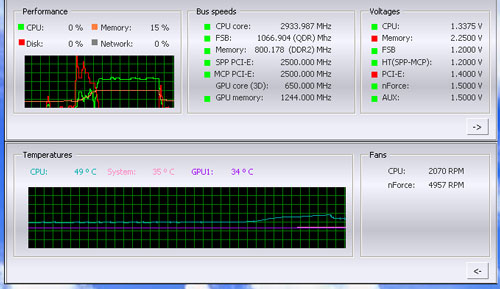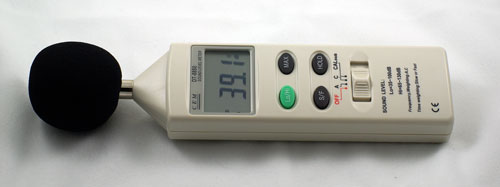Cooler Master Hyper 6+: Universal Heatpipe Tower
by Wesley Fink on February 14, 2007 12:02 AM EST- Posted in
- Cases/Cooling/PSUs
CPU Cooling Test Configuration
The standard test bed for cooling tests is the EVGA NVIDIA 680i SLI motherboard. This is primarily based on the consistent test results on this board and the excellent NVIDIA Monitor temperature measurement utility, which is part of the nTune program.

NVIDIA Monitor has a drop-down pane for temperature measurement which reports CPU, System, and GPU results. Reviews at this point will concentrate primarily on CPU temperature. In addition to the real-time temperature measurement, NVIDIA Monitor also has a logging feature which can record temperature to a file in standard increments (we selected every 4 seconds). This allows recording of temperatures during testing and play back, for example, of stress test results that can then be examined when the stress tests are completed. There is also the handy reference of speeds and voltages in the top pane to confirm the test setup.
Other components in the cooling test bed are generally the same as those used in our motherboard and memory test bed:
All cooling tests are run with the components mounted in a standard mid-tower case. The idle and stress temperature tests are run with the case closed and standing as it would in most home setups. We do not use auxiliary fans in the test cooling case, except for the north bridge fan attached to the 680i for overclocking.
We first tested the stock Intel cooler at standard X6800 speed, measuring the CPU temperature at idle and while the CPU was being stressed. We stressed the CPU by running continuous loops of the Far Cry River demo. The same tests were repeated at the highest stable overclock we could achieve with the stock cooler. Stable in this case meant the ability to handle our Far Cry looping for at least 30 minutes.
The same tests were then run on the cooler under test at stock, highest stock cooler OC speed (3.73GHz), and the highest OC that could be achieved in the same setup with the cooler being tested. This allows measurement of the cooling efficiency of the test unit compared to stock and the improvement in overclocking capabilities, if any, from using the test cooler.
Noise Levels

In addition to cooling efficiency and overclocking abilities, users shopping for CPU cooling solutions may also be interested in the noise levels of the cooling devices they are considering. Noise levels are measured with the case open on its side and are measured using a C.E.M. DT-8850 Sound Level meter. This meter allows accurate sound level measurements from 35bdB to 130dB with a resolution of 0.1dB and an accuracy of 1.5dB. This is sufficient for our needs in these tests, as measurement starts at the level of a relatively quiet room. Our own test room, with all computers and fans turned off, has a room noise level of 36.4dB.
Our procedures for measuring cooling system noise are described on page seven along with noise results comparing the stock Intel cooler and recently tested CPU coolers to the Cooler Master Hyper 6+.
The standard test bed for cooling tests is the EVGA NVIDIA 680i SLI motherboard. This is primarily based on the consistent test results on this board and the excellent NVIDIA Monitor temperature measurement utility, which is part of the nTune program.

NVIDIA Monitor has a drop-down pane for temperature measurement which reports CPU, System, and GPU results. Reviews at this point will concentrate primarily on CPU temperature. In addition to the real-time temperature measurement, NVIDIA Monitor also has a logging feature which can record temperature to a file in standard increments (we selected every 4 seconds). This allows recording of temperatures during testing and play back, for example, of stress test results that can then be examined when the stress tests are completed. There is also the handy reference of speeds and voltages in the top pane to confirm the test setup.
Other components in the cooling test bed are generally the same as those used in our motherboard and memory test bed:
| Cooling Performance Test Configuration | |
| Processor | Intel Core 2 Duo X6800 (x2, 2.93GHz, 4MB Unified Cache) |
| RAM | 2x1GB Corsair Dominator PC2-8888 (DDR2-1111) |
| Hard Drive(s) | Hitachi 250GB SATA2 enabled (16MB Buffer) |
| Video Card: | 1 x EVGA 7900GTX - All Standard Tests |
| Platform Drivers: | NVIDIA 9.53 |
| NVIDIA nTune: | 5.05.22.00 (1/16/2007) |
| Video Drivers: | NVIDIA 93.71 |
| CPU Cooling: | Cooler Master Hyper 6+ Vigor Monsoon II Lite Thermalright MST-9775 Scythe Katana Tuniq Tower 120 Intel Stock HSF for X6800 |
| Power Supply: | OCZ PowerStream 520W |
| Motherboards: | EVGA nForce 680i SLI (NVIDIA 680i) |
| Operating System(s): | Windows XP Professional SP2 |
| BIOS | Award P24 (1/12/2007) |
All cooling tests are run with the components mounted in a standard mid-tower case. The idle and stress temperature tests are run with the case closed and standing as it would in most home setups. We do not use auxiliary fans in the test cooling case, except for the north bridge fan attached to the 680i for overclocking.
We first tested the stock Intel cooler at standard X6800 speed, measuring the CPU temperature at idle and while the CPU was being stressed. We stressed the CPU by running continuous loops of the Far Cry River demo. The same tests were repeated at the highest stable overclock we could achieve with the stock cooler. Stable in this case meant the ability to handle our Far Cry looping for at least 30 minutes.
The same tests were then run on the cooler under test at stock, highest stock cooler OC speed (3.73GHz), and the highest OC that could be achieved in the same setup with the cooler being tested. This allows measurement of the cooling efficiency of the test unit compared to stock and the improvement in overclocking capabilities, if any, from using the test cooler.
Noise Levels

In addition to cooling efficiency and overclocking abilities, users shopping for CPU cooling solutions may also be interested in the noise levels of the cooling devices they are considering. Noise levels are measured with the case open on its side and are measured using a C.E.M. DT-8850 Sound Level meter. This meter allows accurate sound level measurements from 35bdB to 130dB with a resolution of 0.1dB and an accuracy of 1.5dB. This is sufficient for our needs in these tests, as measurement starts at the level of a relatively quiet room. Our own test room, with all computers and fans turned off, has a room noise level of 36.4dB.
Our procedures for measuring cooling system noise are described on page seven along with noise results comparing the stock Intel cooler and recently tested CPU coolers to the Cooler Master Hyper 6+.










25 Comments
View All Comments
Casper42 - Friday, April 6, 2007 - link
I bought 2 of these for a Dual Opteron setup back in September of 2005!!!What the hell took you guys so long to review them?
PS: For the haters that keep harping on the 100mm fan, you could make a 100 to 120 adapter out of a peice of sheet metal and a few power tools. If your so l334 that you have to have the super special $25 uber quiet 120mm fan, show your skills and make your own adapter.
Hell that gives me an idea. My father in law has a Digital Plasma Cutter, he could probably work out plans for such an adapter in a matter of a few hours and then crank them out from sheet alumn.
schlumpfi106 - Thursday, February 15, 2007 - link
Why is that a small complaint? It makes this cooler absolutely useless in my eyes. Not worth testing.
Missing Ghost - Saturday, February 17, 2007 - link
It's still better than integrated fans as found on many Zalman coolers.Macuser89 - Monday, February 19, 2007 - link
Why is an integrated or abnormal fan size bad. unless you want to change the fan for some reason, I can't think of anything.flipmode - Thursday, February 15, 2007 - link
FWIW, I would really like to see you guys test the Scythe Ninja. It should nip at the heels of the Tuniq, has a decent mounting system, a quiet fan, a good price, and wide availability.flipmode - Thursday, February 15, 2007 - link
That's silly, plain silly. Take you eyeball and point it at those serrations. Now, do you see a significant increase of surface area there? No - The "teeth" are a few millimeters square at best. A more plausible explanation is that they are there to reduce static pressure. The method has been used on other heatsinks - The Thermalright Ultra-120 and the Tuniq Tower for instance, but the serrated profile of this Coolermaster departs significantly from the profiles of the other two - so I wonder if my theory is correct or if the serrations exist for a completely different reason. But I'm quite comfortable asserting that they're not intended to increase surface area.stelleg151 - Wednesday, February 14, 2007 - link
my vote is to start using the QX6700 for OC testing, more heatMacuser89 - Thursday, February 15, 2007 - link
too much work... they have more data to compare with x6800.Gigahertz19 - Wednesday, February 14, 2007 - link
Jarred, WesleyYou guys should included the Thermaltake Typhoon VX in a future HSF review. It hasn't been out that long but is suppose to be one of the quietest coolers with awesome cooling. I remember reading its performance is very similar to the Zalman 9700 but the Typhoon VX can produce the same results yet remain much quieter.
Macuser89 - Wednesday, February 14, 2007 - link
Which is better, Copper or Aluminum for a heat sync? I would think Copper, but some say otherwise. And if Copper is better then wouldn't the Tuniq be better yet if they used copper fins as well.